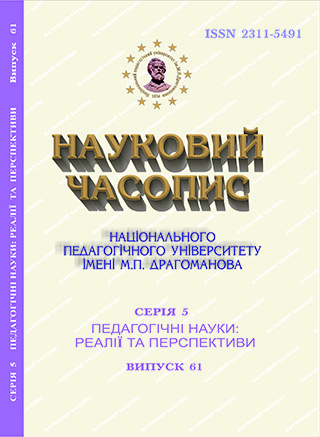DIFFERENTIATED APPROACH TO FOREIGN LANGUAGE LEARNING
Ключові слова:
differentiated instruction, differentiated approach, differentiation, individual approach, educational technology, teaching methods, profession-oriented foreign language, person-oriented teachingАнотація
The article is devoted to the problem of implementation of differentiated instruction of foreign languages at higher educational institutions. The authors substantiate the principles of differentiated instruction, as an educational technology, fortraining future specialists of technical speciality, forms and means of differentiated instruction, pay attention to some special
features of applying differentiated instruction in technical universities; and characterize teaching methods and ways that can be
used when learning a profession-oriented foreign language. The article points out the differences between the individualization
and differentiation, lists the advantages of the differentiated approach of teaching students of higher educational institutions in
the process of studying a foreign language.
The processes of globalization and European integration, the establishment of international business contacts between
Ukrainian specialists and colleagues from different countries raises the need of highly skilled professionals who fluently communicate in a foreign language. Therefore, the competitiveness of a modern specialist is determined not only by his qualifications
in the professional field, but also by the level of knowledge of a foreign language.
In this regard, the search for ways of increasing the efficiency of training in a technical university, where the availability of
multi-level groups is the objective condition of the pedagogical process. Teachers of a foreign language at technical universities
are constantly facing the problem of organizing academic work at a multilevel linguistic training of the first-year students. Differences in the language training of students lead to the need for differentiated instruction of a foreign language, which allows taking
into account the individual characteristics of students, reveals their potential, develops autonomy and confidence in their abilities.
Посилання
Унт И. Е. Индивидуализация и дифференциация обучения / И. Е. Унт – Москва : Педагогіка, 1990. – 192 с.
Чередов И. М. О дифференциации обучения на уроках / И. М. Чередов. – Омск, 1973. – 155 с.
Артюхов М. В. Дифференциация как условие развития инновационных процессов в образовании / М. В. Артюхов // Дифференциация образования. Региональная стратегия и тактика обеспечения инновационных процессов. – Новокузнецьк : НДПКІ, 1996. – С. 88-109.
Загвязинский В. И. О дифференцированном подходе / В. И. Загвязинский // Народное образование, 1968. – № 10. – С. 16-23.
Голант Е. Я. Дидактические основы дифференцированного обучения / Е. Я. Голант // Актуальные проблемы индивидуализации обучения: Материалы научного симпозиума. – Тарту : Тарт. кн. изд-во, 1970. – С. 44-52.
Русская педагогическая энциклопедия: в 2-х т. / гл. ред. В. В. Давыдов. – Москва : БРЕ, 1993. – Т. 1. – С. 276.
Селевко Г. К. Современные образовательные технологи / Г. К. Селевко // Учебное пособие. – Москва, 1998. – С. 80.
Чуриков И. А. Индивидуально-дифференцированный подход к учащимся как эффективное средство активизации познавательной деятельности. / И. А. Чуриков. – Казань, 1973. – 18 с.
Tomilson C. A. Differentiating instruction: Why bother? / C. A. Tomilson. – Middle Ground, v. 9 n. 1, 2005. – P. 12-14.
Tomlinson C. A. Differentiation in Practice / C. A. Tomlinson, C. A. Strickland. – V. A., USA : Association for Supervision and
Curriculum Development, 2005. – 356 p.
Roberts J. Strategies for differentiating instruction best practices for the classroom / J. Roberts, T. Inman. – Waco, Texas : Prufrock
Press Inc., 2007. – 324 p.
Irujo S. Differentiated instruction: We can no longer just aim down the middle. ELL Outlook. – 2004. September/October.


